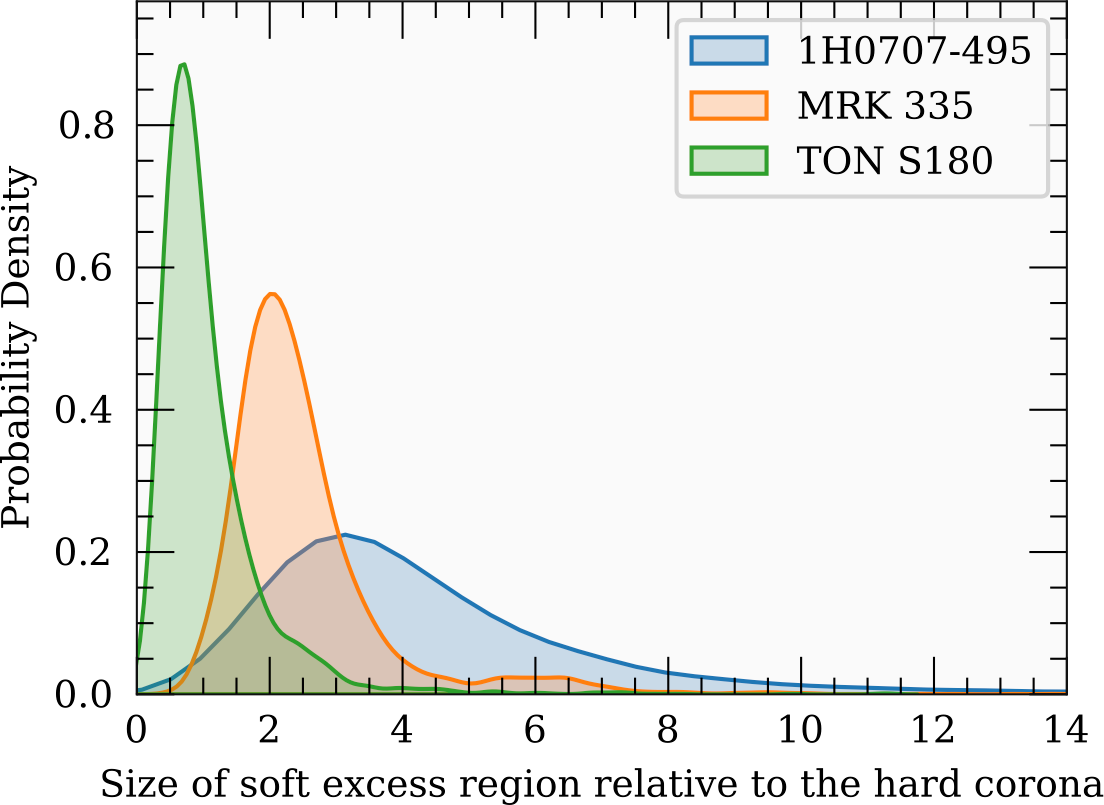NICER / ISS Science Nugget
for November 16, 2023
Sizing up the soft excess from galaxy cores
Most of the radiation observed from the cores of distant galaxies is produced by gas accretion onto a supermassive black hole at the center. The released energy is observed in different parts of the spectrum: optical and UV emission is produced by the accretion disk, while X-rays are produced in a hot corona very close to the black hole itself. Along with these two relatively well-understood components, a "soft excess" component is often observed and its origin has remained a puzzle. It is an excess of emission in the soft X-ray band (0.2-2 keV photon energies) that is observed in many active galaxies. Initially, it was thought to be the thermal emission from the accretion disk itself, but as more data are collected, other models have been required. Among them are reflection of the coronal emission in the disk, or an extra "warm" corona (in addition to the hot one) that exists somewhere around or in-between the hot corona and the accretion disk.
Finding the origin of the soft excess is crucial for understanding the accretion energy budget, and for probing how matter behaves in the vicinity of the black hole. Key missing details include the size of the emission region, its location, and its emission mechanism. Research has typically focused on modeling the X-ray spectrum, or studying the fast variability (less than ∼1 day timescales). NICER opened a new window where the long-term variability can be tracked on months timescales, offering a new discovery space. Using long monitoring observations of three objects that show a soft excess in their spectra, work by A. Zoghbi (Univ. of Maryland and NASA/GSFC) and collaborators, recently published in The Astrophysical Journal, attempts to measure the size of the soft excess region directly by tracking how it varies with time.
The basic principle of the measurement is that small regions show more variability than larger regions. By tracking how the soft excess (observed at energies < 1 keV) varies relative to the hot corona (observed at energies > 1 keV), the relative size of the two regions can be measured. The study finds that for TON S180, the size of the soft excess region is comparable to the hot corona, suggesting that the relativistic reflection model or the warm corona that sandwiches a hot corona are possible geometries. On the other hand, for 1H 0707-495 and Mrk 335, where the soft excess region is larger than the corona by a factor of 2-4, a warm corona that is larger than the hot corona appears to be more consistent with the data. This is the first time the relative sizes have been quantified independently of the assumptions of any spectral models.


Left: Illustration of the different configurations that correspond to the different models proposed for the soft excess. The left-hand scenario is for a relativistic reflection model, where the hot corona (blue) illuminates the disk, producing emission lines that, when produced very close to the black hole, are broadened and smeared out. The other two images are for the case of a warm corona: a layer above the disk that is heated by internal dissipation, distinct from the hot corona, and a warm corona, co-located with the hot corona, that radiates inward of some radius R_corona, while a standard disk emits outside it.
Right: Probability density of the relative size of the soft excess to the hot corona. The relative size is obtained as the ratio of the summary parameter for soft excess variability (power spectrum break in 1H 0707-495 and the total integrated root-mean-square variability for TON S180 and Mrk 335).
<< Previous
Main Index
Next >>